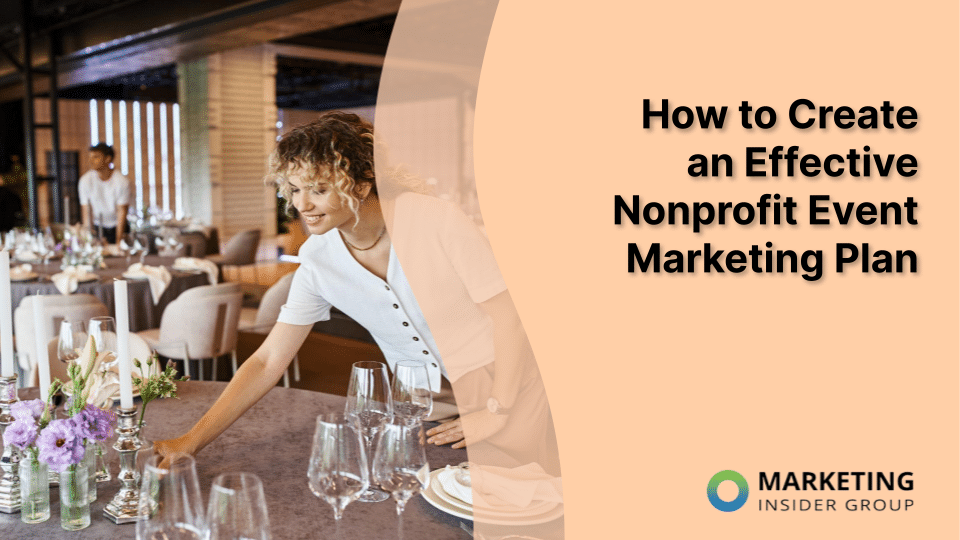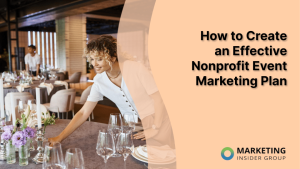
Effectively marketing a nonprofit event requires more than just hoping it becomes popular through word of mouth. At the same time, your nonprofit needs a way to publicize your event and build excitement without overspending on a limited event budget.
If you have a nonprofit event coming up, whether small or large, explore the following key steps to create a plan for marketing your event. In doing so, you can build momentum and increase attendance through effective and cost-efficient means.
1. Review Past Event Marketing Performance
To develop a thorough and informed event marketing plan, you first need to understand what you’ve done in the past. Review past events and the marketing strategies you used. Specifically, note what methods had the most success, which were the most cost-effective, and any that were ineffective.
To unlock concrete insights from your analysis, use concrete information. Look at metrics and feedback such as:
Attendance: Overall attendance and attendee demographics
Engagement: General participation, sign-ups, event-specific sales, and post-event engagement
Fundraising: Total funds raised, funds raised through different channels, pre-event and during-event sales
Feedback: Attendee comments and vendor feedback
Goals: Actual attendance, fundraising, and impact compared to what was expected.
By reflecting on your past goals and performance, you can set more realistic yet ambitious goals for your upcoming event.
2. Set Attainable Goals and Objectives
With an understanding of previous goals and whether they were met, you can adjust future goals accordingly. For example, you might set attendance, fundraising, and engagement goals for your next event.
Your goals should be specific, measurable, achievable, relevant, and time-bound (SMART). These goals can be raw numbers, such as X number of attendees or Y dollars raised. They also could be a percentage based on a previous event, such as raising attendance or engagement by Z%.
Objectives may be more generalized than specific goals. For example, objectives might be to raise awareness or support a specific community. These should inform the relevancy of your SMART goals.
3. Understand Your Nonprofit’s Target Audience
You must understand your nonprofit’s target audience to connect with them. By learning about their interests, you can tailor your event messaging to excite and engage.
Consider creating personas based on different types of potential attendees. Create two to six personas (depending on your event’s scope) using details like the following:
Demographic: Age, gender, income, location, etc.
Psychographic: Values, beliefs, interests, lifestyles, etc.
Behavior: Engagement with nonprofits, use of social media platforms, and other known actions
To better understand your target audience, conduct surveys and focus groups. Also, keep in mind that one event’s target audience might be different from another event’s audience. You may want different personas for different types of events, from advocacy events to formal galas.
4. Keep Your Event’s Messaging Consistent
Align your nonprofit’s messaging with audience expectations while staying true to your brand. Understand your target audience’s values and interests, and highlight those aspects within your upcoming event.
As you develop messaging for different marketing channels, keep messaging consistent across all of the platforms you use. Social media posts, your website, email announcements, and print materials should all share the same information and voice.
Stories are some of the most effective ways to market a nonprofit event. You undoubtedly have moving stories to share about what your nonprofit has done and hopes to do. It’s the stories that will move people to action and help them remember your messaging.
5. Choose the Best Event Marketing Channels
Selecting the right marketing channels will ensure that you get in front of your target audience. Which channels you should use depends largely on where your target audience is most likely to be active and receptive.
Some channels to consider are:
Social Media: Directly engage people with posts and comments.
Email Newsletters: Share specific information with people who are already interested in your cause.
Website Event Page: Serve as a reference for event information.
Posters: Share a local event on community bulletin boards and other places.
Press Releases: Engage the press, either through a news story or interview.
Radio Announcements: Make announcements on free nonprofit radio stations.
Partnerships: Work with other organizations to get word out about the event.
Paid Advertising: Tap into digital and print if budget allows.
The channels you decide to use is partly determined by the type of event you’re hosting. For example, posters and radio announcements will be more effective for a local event than a large, regional one.
6. Create an Event Marketing Calendar
A well-organized marketing calendar will help you implement your planned strategies and ensure the campaign stays on schedule. It’ll provide a map for everyone involved in the marketing plan to follow, keeping them coordinated and on the same page.
Make sure your marketing calendar is comprehensive, including all channels you’re planning to use and everything that’s to be done on each channel. It also should include idesa for the content you’ll create and deadlines for producing, editing and sharing.
7. Enlist the Help of Loyal Supporters
Engaging with loyal supporters can significantly amplify your marketing reach. These are the people most likely to sign up for your event and tell others about it. Loyal supporters and volunteers are often seen as more trustworthy by potential new supporters, making their endorsements highly valuable.
Whether they’re commenting online, sharing posts, or directly talking about it in person, this word of mouth can be extremely helpful for your event marketing. Some supporters may even be willing to volunteer and help with your event planning.
To incentivize their participation, you might offer:
Event discounts
Branded merchandise
Small gift cards
It can also be useful if you give them materials to share, such as flyers, social media posts, or similar marketing collateral.
8. Identify Metrics to Evaluate Performance
Throughout your event marketing, you should track and evaluate key metrics for effectiveness. Key performance indicators (KPIs) like the following are often useful:
Website traffic
Social media engagement
Registrations or ticket sales
Donations
Review these KPIs as your marketing campaign progresses, so you can see what’s working and what’s not. Make adjustments to your plan and calendar as appropriate.
9. Invest in the Right Tools
To aid you in all of this, invest in marketing tools that make sense. The right marketing tools can streamline operations and enhance the efficiency of your efforts. Some examples of tools that would be helpful include:
Constituent relationship management (CRM) software: Keep track of supporters, donors, and attendees in one place.
Social media management tools: Schedule posts, track analytics, and manage multiple platforms.
Email marketing platforms: Design newsletters, automate campaigns, and segment communications.
Event management software: Handle registration, ticketing, and on-site logistics.
Many effective tools will have some upfront costs, including both a fee and time needed to learn the tools. However, with the right research and training, these costs can more than pay for themselves in saved time and increased effectiveness.
There also are many event solutions that fit within nonprofit budgets, and can be scaled as necessary depending on event size. Some have small free plans that can be scaled up as your nonprofit’s reach and event attendance grow.
A solid event marketing plan provides a roadmap for getting the word out about your upcoming event. By understanding your target audience, crafting compelling messages, utilizing effective marketing channels, and thoughtfully analyzing your results, you’ll attract interested attendees, achieve your fundraising goals, and increase the overall impact of your events.





